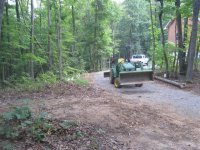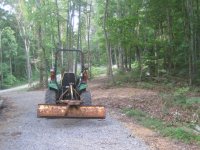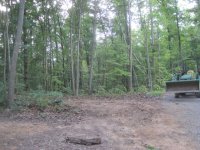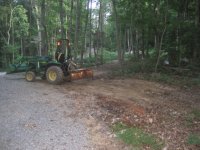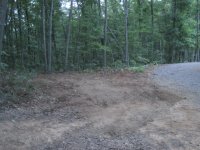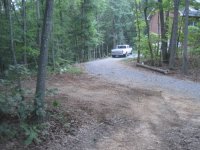Coyote machine
Super Member
- Joined
- May 4, 2009
- Messages
- 7,663
- Location
- Southern VT
- Tractor
- 22 SANY SY 50U, '10 Kioti DK 40se/hst KL-401 FEL, loaded tires, KB-2485 bhoe, Tuffline TB160 BB, Woods QA forks, MIE Hydraulic bhoe thumb & ripper tooth, Igland 4001 winch, & GR-20 Log Grapple. Woods BBX72" Brush Mower. Diamondplate aluminum canopy
Coyote,
Good question. If I need to remove the stump, it's faster to drop the tree with attached stump with the backhoe than to use the chainsaw first. Pushing the tree over while it is still attached to the stump uses the weight of the tree to pull the stump and remaining roots out of the ground. Digging a stump out of the ground by itself requires a lot more digging and is time consuming, especially if there are roots directly below the stump. Also, taking the tree down with the backhoe gives you a lot of control over the direction the tree falls.
The cable was attached to the trunk about 15 feet high. It was only a safety for just in case the tree wanted to fall backwards instead of forward while I was digging on the backside of the tree. It probably wasn't necessary. Most people wouldn't use it under most conditions. However, I was just being extra cautious because I have very little experience taking down trees with a backhoe (or with a chainsaw).
If I had dropped the tree with my chainsaw, I probably would have hooked up the cable anyway, again because of my lack of experience. I have never dropped a tree as large as that maple with a chainsaw. I'm more comfortable trying the bigger trees with the backhoe than the chainsaw. Eventually, I may work my way to dropping a tree that large with my chainsaw. If I don't mind leaving the stump in the ground, dropping the tree with the chainsaw would be faster than using the backhoe.
Obed
Obed, I get what you were trying to do, however I believe your lack of experience with chainsaws and 'bigger' trees in combination with using your tractor hoe actually puts you in greater danger than using proven tree felling techniques. The dig out the stump, have it rip out when the tree falls works in theory but the possibility of the tree going wrong when pushing on it makes anyone who does tree work, or has done tree work for a living cringe. The possibility of the tree top / tree 'barber-chairing' is always a possibility, which could drop the tree on the tractor operator, with no time to prepare or escape serious injury/death, is a not uncommon force to be avoided at all costs.
FWIW, I am enrolling in a multiple stage forestry course, which covers ALL aspects of tree felling, chain saw use and maintenance, and much more, at the higher level stages. It's called: "Game of Logging", and may be available in your area. I found out about it coincidentally on TBN and signed up for the 1st two sessions after reading about it. Though I have years of experience working with trees, saws, etc., one can always hone one's skills and learn new or different ways of doing tree work to improve safety and knowledge. Most prior participants say the techniques they learned are now the only ones they use to fell trees; even highly experienced guys say the same; so that was a good enough endorsement for me to sign-up.
I suggest checking it out on the web, and in person if available in your area.
Stung by a Wasp
Yesterday evening, I got stung by a wasp while trying to attach the scraper blade to the 3PH. Wasps had build a nest inside the implement and I got stung on the back of my right hand through the glove I was wearing. I'm surprised it took the wasps as long as long as it did to nail me. I had moved the blade around on the ground for quite a bit before I got stung. Normally I will immediately put ice on a bee sting to reduce the effects of the poison. However, I had a lot to do before the impending rain arrived so I didn't use the ice.
View attachment 382959
I got some wasp spray and sprayed inside the hollow part of the implement. I then swatted wasps with a broom and sprayed in the air to kill about 3 of them. Finally, I attached the blade to the 3PH while one remaining mad wasp that I couldn't kill flew around.
I put my gloves back on and continued my work. By the time I went to bed, my hand had started swelling. When I awoke this morning, the hand was more swollen. Today by about 5 PM, my hand was looking pretty bad so I wend to a walk-in clinic. They prescribed 7 days of steroids. The nurse practitioner told me for signs to look for that might indicate an ER visit would be needed.
Normally, I don't react this badly to a bee sting. Yesterday evening, while working, sometimes my right hand felt like something was stinging my again but I ignored it and kept working. I am now wondering if the stinger was still in the glove and I was getting multiple ongoing stings from the stinger. It's just a hypothesis. In addition, I bled some where the wasp stung my hand. I suspect the stinger and poison penetrated a vein.
Have you ever tried spray on Benadryl, or the liquid for treating bee stings? I try to use it right after the sting to neutralize the effects of the poison, and alleviate pain/swelling.
CM. (Note, my text in blue above.)
